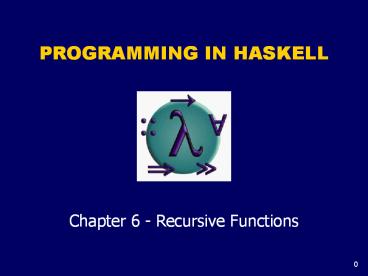Functional Programming - PowerPoint PPT Presentation
Title:
Functional Programming
Description:
PROGRAMMING IN HASKELL Chapter 6 - Recursive Functions * * Introduction As we have seen, many functions can naturally be defined in terms of other functions. fac ... – PowerPoint PPT presentation
Number of Views:103
Avg rating:3.0/5.0
Title: Functional Programming
1
PROGRAMMING IN HASKELL
Chapter 6 - Recursive Functions
2
Introduction
As we have seen, many functions can naturally be
defined in terms of other functions.
fac Int ? Int fac n product 1..n
fac maps any integer n to the product of the
integers between 1 and n.
3
Expressions are evaluated by a stepwise process
of applying functions to their arguments. For
example
fac 4
4
Recursive Functions
In Haskell, functions can also be defined in
terms of themselves. Such functions are called
recursive.
fac 0 1 fac n n fac (n-1)
fac maps 0 to 1, and any other integer to the
product of itself and the factorial of its
predecessor.
5
For example
fac 3
6
Note
- fac 0 1 is appropriate because 1 is the
identity for multiplication 1x x x1. - The recursive definition diverges on integers ? 0
because the base case is never reached
gt fac (-1) Exception stack overflow
7
Why is Recursion Useful?
- Some functions, such as factorial, are simpler to
define in terms of other functions. - As we shall see, however, many functions can
naturally be defined in terms of themselves. - Properties of functions defined using recursion
can be proved using the simple but powerful
mathematical technique of induction.
8
Recursion on Lists
Recursion is not restricted to numbers, but can
also be used to define functions on lists.
product Num a ? a ? a product
1 product (nns) n product ns
product maps the empty list to 1, and any
non-empty list to its head multiplied by the
product of its tail.
9
For example
product 2,3,4
10
Using the same pattern of recursion as in product
we can define the length function on lists.
length a ? Int length
0 length (_xs) 1 length xs
length maps the empty list to 0, and any
non-empty list to the successor of the length of
its tail.
11
For example
length 1,2,3
12
Using a similar pattern of recursion we can
define the reverse function on lists.
reverse a ? a reverse
reverse (xxs) reverse xs x
reverse maps the empty list to the empty list,
and any non-empty list to the reverse of its tail
appended to its head.
13
For example
reverse 1,2,3
14
Multiple Arguments
Functions with more than one argument can also be
defined using recursion. For example
- Zipping the elements of two lists
zip a ? b ? (a,b) zip
_ zip _ zip (xxs)
(yys) (x,y) zip xs ys
15
- Remove the first n elements from a list
drop Int ? a ? a drop 0 xs
xs drop _ drop n (_xs) drop (n-1)
xs
- Appending two lists
() a ? a ? a ys
ys (xxs) ys x (xs ys)
16
Quicksort
The quicksort algorithm for sorting a list of
values can be specified by the following two
rules
- The empty list is already sorted
- Non-empty lists can be sorted by sorting the tail
values ? the head, sorting the tail values ? the
head, and then appending the resulting lists on
either side of the head value.
17
Using recursion, this specification can be
translated directly into an implementation
qsort Ord a ? a ? a qsort
qsort (xxs) qsort smaller x
qsort larger where smaller a a ?
xs, a ? x larger b b ? xs, b ? x
Note
- This is probably the simplest implementation of
quicksort in any programming language!
18
For example (abbreviating qsort as q)
q 3,2,4,1,5
19
Exercises
(1)
Without looking at the standard prelude, define
the following library functions using recursion
- Decide if all logical values in a list are true
and Bool ? Bool
- Concatenate a list of lists
concat a ? a
20
- Produce a list with n identical elements
replicate Int ? a ? a
- Select the nth element of a list
(!!) a ? Int ? a
- Decide if a value is an element of a list
elem Eq a ? a ? a ? Bool
21
(2)
Define a recursive function
merge Ord a ? a ? a ? a
that merges two sorted lists of values to give a
single sorted list. For example
gt merge 2,5,6 1,3,4 1,2,3,4,5,6
22
(3)
Define a recursive function
msort Ord a ? a ? a
that implements merge sort, which can be
specified by the following two rules
- Lists of length ? 1 are already sorted
- Other lists can be sorted by sorting the two
halves and merging the resulting lists.































